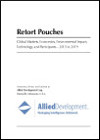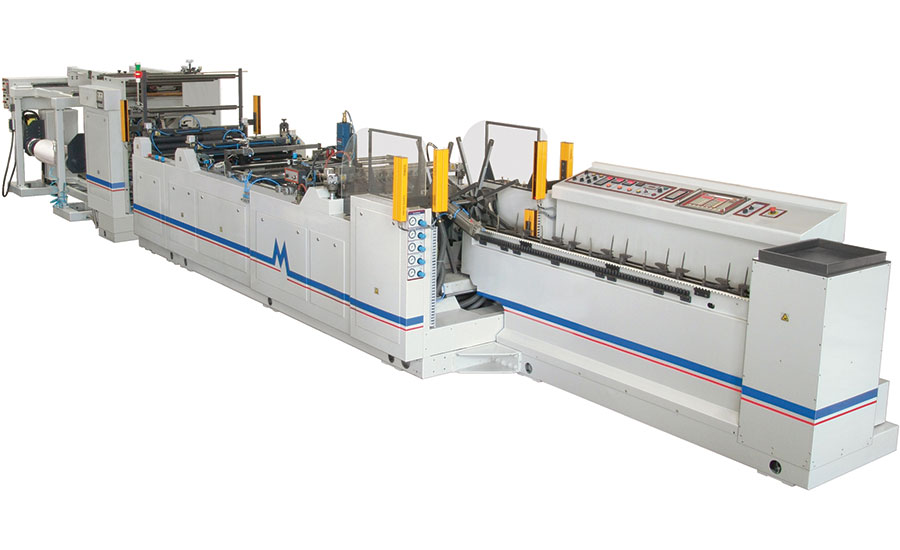Roundtable: Special Advertising Section
May 2019 Roundtable on Bag/Pouch Making
















We sat down and discussed bag/pouch making with Sanjay Amin from Mamata Enterprises, Inc., Scott Fuller from CMD Corporation, Raul Matos from Karlville, James F. Pease from Sun Centre USA, Jesse Rosenow from Totani America, James Russell from Modern Manufacturing Services, LLC, and Joe Vannieuwenhoven from B&B Packaging Technologies. What follows are the excerpts from that discussion.
 Sanjay Amin
Sanjay Amin
General Manager-Sales; Marketing Customer Support
Mamata Enterprises, Inc.
18 years with the company
(630) 801-2320
mamatausa.com
 Scott Fuller
Scott Fuller
Product Line Manager: Intermittent Motion
Sales Manager: N.A., Non-Medical Pouch
CMD Corporation
10 years with the company
(920)-740-8728
www.cmd-corp.com
 Raul Matos
Raul Matos
Vice President
Karlville
22 years with the company
(305) 533-1051
www.karlville.com
 James F. Pease
James F. Pease
President/CEO
Sun Centre USA
19 years with the company
(224) 699-9058
www.suncentre.us
 Jesse Rosenow
Jesse Rosenow
Sales Engineer
Totani America
7 years with the company
(920) 632-7319
www.totaniamerica.com
 James Russell
James Russell
President
Modern Manufacturing Services, LLC
10 years with the company
(585) 289-4261
www.modernmfg.net
 Joe Vannieuwenhoven
Joe Vannieuwenhoven
Dir. of Sales & Marketing
B&B Packaging Technologies
2 years with the company
(920) 469-9648
www.bub-group.com
What’s new with your company in bag/pouch making? Have you released anything new or upgraded any existing equipment?
Russell: At Pack Expo last fall, Modern had the first live showing of our new Momentum Series with InteliSeal. This new technology, is a servo actuated system that enables variable cycle and seal compression distances. These enable the Momentum series to run a wider variety of films, including COEX, Poly/Poly and recyclable material. This new product line satisfies the need for rapid changeovers and short runs. In the end, this allows customers to take advantage of niche and promotional pouch applications.
Fuller: CMD launched the 760-SUP Stand-Up Pouch System in 2018 as an answer to specific converting needs not addressed in the market. These needs were articulated by the converters we talked to during the research phase of the project. While exhibiting the system at Pack Expo 2018, we focused on listening closely to the feedback we received from visitors:
- “The open design makes for significantly faster changeovers — a real cost-saver.”
- “Straightforward and intuitive — this will be a breeze to train operators on.”
- “A die-change in 2 minutes!”
- “Impressive technology — a smart machine that will give me the data I need to operate at a profit.”
- “Very impressive performing machine.”
Like any good OEM, our focus is to continually improve and advance our systems to bring value and benefit to our customers. So, we’ve redesigned the unwind to reduce the footprint of the machine, and offer an L-shaped configuration for footprint flexibility. The robust nature of the high-performance machine ensures profitable output and consistent product quality, while noise reduction measures have really quieted the system. The 760-SUP was run in one-up configuration at Pack Expo and is also capable of 2-up production.
We’ve also recently developed an Inserted Bottom Gusset module for this system. Our desire was to simplify this process as much as possible, without the limitations of a prior design to hold us back. The result is profitably efficient set-up - even on a multi-format configuration that can run either plowed-bottom gusset or inserted-gusset pouches on the same machine - driving more profit directly to our customer’s bottom line.
Vannieuwenhoven: B&B Packaging Technologies continues to develop innovative bag and pouch making machinery. Representative of B&B’s state-of-the-art technology is our newest model, STBB 8E, pouch making machine capable of capable of producing spouted stand-up pouches. STBB 8E fully integrates the insertion of the spout inline at speeds up to 200 bags per minute. B&B designed and produces a superior system to sort and properly deliver the fitments into position for up to four inline spout inserting systems. We also integrated is a complete detection system that incorporates a mixture of two and three-dimensional camera systems that measure critical areas of the pouch making process including seal presence, widths, shape, and positional accuracy of the fitment sealed in place, and rejects pouches that have any flaws.
In January, B&B’s launched “LEAP” its newest “Line Extension Automated Packaging” robotic packaging system that can be integrated on new and existing B&B machinery that automates packing of bags into large corrugated boxes and gaylords.
Additionally, for many years, B&B has developed machinery for recyclable polyethylene film structures. We have machines producing side gusset pouches with PE structures using one web. B&B’s commitment to sustainability focuses its effort on developing machinery to produce stand up pouches and flat bottom bags based on recyclable films.
Pease: Sun Centre USA’s machinery is now producing multi-chamber pouches based on Arranti’s patented pouch designs for creating stand-up flexible, gusseted pouches with up to three separate chambers, ideal for selling combinations of two or more products that are typically used together or mixed. We can also produce perforated pouches that allow chambered pouches to be fully separated.
Sun Centre USA will soon be launching new machinery for producing high quality, digitally printed paper bags for retail and single use applications, with or without a variety of handle options. With the industry moving toward sustainable, recyclable packaging, we see paper bags as being a viable alternative to stand-up pouches. Another key initiative at Sun Centre is adding RFID and augmented reality graphics to various styles of packaging.
Rosenow: The industry has spoken and, yet again, Totani has listened. The Totani model CT-35 for single-lane stand-up pouch with zipper production boasts a compact design that is a perfect fit for the converter who is looking for a quick changeover, low set-up scrap machine. The 35cm bed also makes it ideal for the narrow web and/or digital printer.
On another end of the pouch spectrum, Totani has worked to improve upon their line of Box Pouch machines by adding the SG-10 to the lineup. This machine will be capable of producing pouches of a full meter in height (39.3”) complete with the added benefit of bottom and side gussets with or without 45˚ termination (standard on all Totani Box Pouch machines). The SG-10 will also mark the beginning of Totani’s evolution to their “E-model” series of machinery with notable improvements across the board. The future of Totani is truly looking as bright as ever.
Matos: Karlville opened a new Swiss office in 2018 to design and fabricate pouch converting machines for global marketplace. Karlville Swiss is managed by Gustavo Guzzi and Gianfranco Locatelli, both seasoned pouch machinery sales and engineering professionals. Last year, Karlville Swiss introduced the second generation of fast change, low waste, pouch making machines. These machines are designed to meet the growing market demands of HP Indigo digital flexible packaging converters as well as traditional flexible packaging operations looking to improve the efficiency of short to medium run business. One of our key innovations is intuitive software to help set up jobs with low waste. Our goal is to set up a job with 25 meters of waste in less than 30 minutes. This is a big paradigm shift in the industry, whereas normal change over time averages from 1.5 to 2.0 hours and 150-200 meters of set up waste.
Amin: With increasing requirement for ability to process and convert recyclable films, Mamata has enhanced our capability to do so across our product range. Pouches, bags and sacks converted from PP Woven Fabric laminated with BOPP are recyclable substrates. We have recently introduced a converting machine to convert such fabric into pouches/sacks. The machine does forming, back-seam gluing, cutting, bottom fold & stitching inline at extremely high speeds of up to 100 bags/minute. The machine is capable of producing 10” x 12” on smaller size and 24” x 40” on larger size.
What are some key factors that might lead a converter to upgrade or replace their existing bag/pouch machinery, even if it seems to be working OK?
Fuller: Upgrading or replacing equipment is a substantial investment, one that should be researched carefully. Equipment should be flexible to adapt to new market and customer requirements, but robust enough to last for many years and deliver a profitable return. Some factors that drive this decision are:
Business Growth
- Will a new machine provide additional capacity, or a competitive advantage or both? Will you gain new customers and grow your business because of increased productivity, expanded SKUs, or a higher quality pouch?
- Does your OEM partner with you to develop new pouch styles and products?
- Does your OEM offer a testing lab that allows you to validate new materials on their systems?
Consider the age of the equipment
- Aging machine = old technology, making you less competitive.
- Newer technology can provide greater efficiency, enhancing profitability.
- Costly obsolescence issues will surface with old components and controls systems.
- Analyze the cost of repairs that an older machine may have.
- The older equipment, the more likely it will need repairs.
- Will parts still be available when needed for older systems?
- What is the impact of downtime due to needed repairs?
Safety
- A new machine may enhance the safety and well-being of your employees without sacrificing productivity.
Considering these factors will provide information to help converters make sound, data-driven decisions rather than emotional ones. At the end of the day, converters need to do their homework, research their options to find a machine that best meets their needs, from an OEM who will be their partner and will be there for them long after the sale.
Vannieuwenhoven: Customers ever increasing demand for new package formats that use sustainable material structures creates an ongoing opportunity to integrate new capabilities with existing machines intensifies B&B’s effort to maximize asset utilization for its customers. B&B works closely with current and future customers to understand their needs to provide solutions that address their requirements in cost-effective ways. B&B machines are built with a modular design to make it easier to add new features in pouch design. Because of the shorter run jobs and faster turnaround time, we have also added auto-changeover to reduce the changeover time between jobs.
Pease: Adding new capabilities through new machines or machine upgrades allow contract pouch producers to attract new customers or become a single source to existing customers with varying pouch needs. Fitment insertion, zipper closure, die-cut shapes become important in landing new orders. Our new machines can deliver key technology to run faster, better and with greater pouch versatility, including front/back registration to create gusseted, stand-up pouches from only two films. This is very important for those with narrower digital printing presses. Double-cut knife technology, now standard on all our new machines, can remove the press brake void in printed films to produce a pouch with edge-to-edge graphics.
Rosenow: Sometimes “OK” just isn’t good enough. Today’s market puts a lot of pressure on converters to deliver more in less time. Lesser made machines lack dependability and ease of operation making them an easy target for replacement. Totani machines have proven time and time again to not only hold their value over time (try finding one on the used machinery market!) but they also are easily upgraded. Produced with a modular design and backed up by the most innovative development team in the industry, a market-chasing upgrade is often just a phone call away.
Matos: When talking about pouch-making machinery, the most important factors that attract my attention are easy at operation, quick setup and less waste. Considering small to medium jobs, customers can finish 30 percent more jobs than their older machine. This converts to a smart business investment as well as helps to prepare converters for the ever-changing demand for digital print converting. Our machine helps to lower cost by transferring smaller jobs to gain efficiency. This efficiency gain helps customers to replace older assets that are more difficult to run and change over.
Amin: One of the key issues for a buyer of pouch machines is to process a wide variety of film structures on the machine besides flexibility to process wide variety of pouch styles. Mamata’s unique seal technology allows customer to use a wide variety of films and pouches. In fact, our customers have run a straight monolayer PE film to an 8 mil PE/Nylon/PE structure and have made stand-up pouches. We can run laminated structures as well as co-ex recyclable unsupported PE structures and make a wide variety of pouches, be it three side seal, zipper, stand-up or even quad-seal pouches for pet food, fertilizers, etc.
Russell: As with any manufacturing business, it’s all about reducing costs, increasing productivity and improving output quality. The InteliSeal helps with all of these key priorities. With our early installations, customers have seen significantly reduced changeover times, higher run rates and drastically reduced set up waste. With the introduction of InteliSeal, the Momentum line has become one system that can satisfy both the short-run (digital) jobs and long-run production jobs. As shown at the past Pack Expo, the new Momentum series pouch line is capable of producing stand-up pouches, with zipper, up to 200 cycles per minute in sustainable production environments.
Aside from the standup pouch, are there any pouch formats you believe to be emerging in the market? If so, for what applications?
Vannieuwenhoven: B&B recognized years ago there is considerable demand for custom formats such as flat-bottom terminated side gusset pouches, and therefore, invested in developing advancements for unique packing solutions as illustrated by SFB 8E-L-FFB machinery. Inline the flat bottom panel is introduced using B&B’s patented technology for speeds of up to 60 bags per minute. SFB 8E-L-FFB bag making machinery is designed for maximum versatility and capable of producing both large and small bag formats and closures. We also can produce flat bottom bags both one-up and two-up.
Pease: The US packaging industry is quickly moving toward sustainable and recyclable material. Now, 100 percent recyclable polyethylene pouches for bulk product such as pet food, fertilizer, etc. are growing in demand. These films will no longer be laminated structures — consequently, impossible for many pouch machines to handle. In fact, the sealing technology is entirely different from that used on laminated films. Our machines have been successfully producing polyethylene pouches for the last 10 years, mostly to customers outside the U.S.
Amin: The major shift we see today is conversion from rigid packaging to flexible packaging. This shift is going to have the biggest potential in next two to three years. E-commerce also is driving major changes in packaging today.
Rosenow: The box pouch continues to lead this conversation. This original Totani design has made inroads over the past years in the pet food, food and lawn and garden markets. More recently it has been used in the household (detergent), coffee and beverage industries. The unique design gives the pouch an increased fill volume while utilizing less raw materials. Its five panels also provide ample branding space for product recognition. The applications for this pouch seem to be limitless.
Matos: HP Indigo leads the global market place in digital print technology. Working closely with HP Indigo has allowed us to think outside the box. The legacy flexible packaging industry has always concentrated in customized web widths to lower cost. This requirement creates longer lead times and added inventory that relate to extra logistics and operational cost specifically when dealing with shorter run applications. With HP Indigo Multi-Lane Ganging Algorithms, a new generation of converters will be able to achieve better frame utilization, optimized production cost and waste minimization. Designing for the future, we will showcase at this year’s Label Expo, a third generation multi web pouch machines to allow converters to pursue multi-lane ganging strategies to convert the pouch with one web or three webs for best TCO, Total Cost of Ownership.
Russell: At Modern, we’re seeing enormous growth in liquid packaging. Not unlike standard pouch making, liquid packaging has some of the same advantages. It’s cost effective due to reduced material required for production and reduced transportation costs. It also requires less shelf space for storage and shelf space at retail locations. With the growing demand for liquid packaging we see an increasing need for in-line or near-line Fitment or Spout insertion. To meet this demand, we’ve developed tailored fitment/spout insertion systems for virtually any liquid packaging application.
Fuller: The stand-up pouch is taking share from other pouch formats. In the flat pouch category, pillow pouches represent the predominant pouch type, primarily because of their dominance in the candy and snack market. But even this established pouch style is losing market share to SUPs.The stand-up pouch continues to lead all other pouch formats in terms of sustained growth. Food and consumer goods products are transitioning from other formats to SUP, attracted by the product differentiation; large billboard and quality graphics for product branding; convenience features and sustainability factors.
Pet food will continue to lead all SUP pouch application growth due to increased pet ownership and the willingness of “pet parents” to spend lavishly on their 4-legged fur children. The baby food market will continue to see transition from other formats to SUPs. Stand Up Pouches with handles and vent holes will provide growth in fruit and vegetable applications. And of course, child-resistant cannabis packaging will see strong growth as well. Shaped pouches are popular for specific products, so having an affordable die-cutting system that can be moved in and out of line with your pouch system can prepare converters for these types of requests from customers.
Improving throughput, reducing changeovers, reducing scrap and reducing maintenance are all ways for converters to maintain profit margins. Are there any other factors you can think of?
Pease: Adding machine updates for employ new technology is key. Dedicated tooling can make set-up easier, improve run rates, and result in greater quality. Such retrofits can be expensive, and typically entail long lead times from offshore OEMs. With our expanded machining capabilities in Crystal Lake, IL, we’ve reduced the cost of special machine tooling, as well as machine parts, and shortened turnaround times to give customers affordable and timely ways to be more competitive and secure those big orders for special pouches.
Rosenow: Nothing can be as detrimental to a converter as a returned order. Not only is this an unfulfilled promise but it often leads to a strained or damaged relationship with the customer which, in the end, is a loss of profits. While all of the factors mentioned here are important, the final quality of the product leaving the converters facility is paramount. Simply put, high quality pouches come from high quality machines. Not only is the reliability there, but also the appropriate technology to sense and reject imperfect pouches. Quality control procedures will always have a place but ensuring that things such as missed gusset tack holes, splicing tape and misfolded gussets, for example, never make it past the converting machine is the first line that should not be overlooked.
Matos: Film set-up stock. With Digital Printing as well as conventional print methods, set up stock is a costly consideration for production. It our goal to keep the setup to 25 meters versus the conventional 150 to 200-meter stock for standup pouch configurations.
Russell: All of the things previously mentioned lead to uptime or the amount of production time that is available to produce jobs. It all starts with a finely engineered product with outstanding reliability and includes parts and support availability when needed. Reducing downtime is the enemy we battle for our customers every day.
Fuller: I guess we did our research, because the focus of the new CMD 760-SUP design is directly aligned with the factors you list. At CMD, we continuously take the time to talk to and listen to the market and time and time again we hear how important Total Cost of Ownership (TCO) is to converters, and rightfully so. So yes, it’s about all the items you mentioned and then some. It’s looking at various financial and performance numbers to maximize profit. At the end of the day, everyone is in a for-profit business.
Vannieuwenhoven: Intuitive HMI screens that make it easier for operator training and bring them up to date quicker. Advanced software providing access to operator training aids and the machine operator manual with full parts list is critical for customers to have the tools necessary to operate in a competitive manner. Given that today’s machinery is more complex and versatile, the machine footprint can also be an issue for converters. There will always be a significant focus on overall footprint and layout configurations that take into account the customers’ needs and their optimized workflow, to minimize the number of operators to run a machine, and to take into account any constraints customers have given their plant layouts.
Can you explain the one or two features of your bag/pouch making equipment that converters like the most?
Rosenow: When partnering with Totani, converters can count on many things but two stand out in particular: reliability and service. Totani machines have been called by many as the workhorse of the facility. The trust that converters place in the machine to run day in, day out is a testament to the reliability of the machine. If the machine does happen to have an issue or consumable parts are needed, Totani machines are backed by the best service/parts team in the industry. This type of confidence makes Totani a unique partner in the industry.
Matos: The machine has high performance design features for K Seals and Ultrasonic Sealing. The units are compact, convenient to set up and efficient. Converters will also like our multi servo technology with a standard base of six servos motors. The multi servo platform helps with simplification and performance.
Russell: Historically speaking, customers have always liked our ability to customize/tailor our products for the applications they need to produce. However, with the installation of our InteliSeal enabled units, we’re seeing our customers rave about the flexibility of our systems to handle a wide variety of pouch applications, all while producing “show quality” pouches at high cycles per minute. The most important factor in all of this is ease of use. As with any manufacturer these days, attracting quality skilled help is challenging. So at Modern we design our controls and machine set-ups to be the simplest in the industry. We factor in that the operators are the ones that are creating the performance. If they have a trouble free set-up, then the machine simply runs better with higher production.
Amin: One of the key features our customers like is the ability to process recyclable films, along with laminates on our pouch machines. They also like Mamata’s technology to control seal time and pressure digitally, allowing for more consistent and high quality sealing.
Fuller: Virtually every converter who has run trials on our new equipment has commented on how easy it is to work on the machine, due to its open design, which helps to make set-ups simpler and quicker. They’ve also been highly complementary of the machine’s simplicity, from a maintenance perspective. fewer touchpoints, and easier access to the items you do have to work on, are benefits that really seem to be resonating with converters.
An advantage of being a relative “new kid on the block” is that CMD offers converters fresh designs and the latest technology, versus the need for some entrenched OEMs to redesign, patch or add-on to existing platforms, which may not bring about optimal performance or results. Another unique aspect of CMD pouch systems has more to do with the converter’s experience with us. Our consultative approach means we’re partners with our customers in their success — throughout the life of their equipment and beyond. An example is our Advanced Engineering Analytics lab, which features our latest technology and is available for our customers and industry colleagues to run film trials for new products and film formulations.
Vannieuwenhoven: Automatic seal positioning systems that require no tools to mount seal bars reduces changeover time between jobs, reduces operator error, and improves the machine ROI calculations. Converters really understand the value of time and express frustration over extensive job changeovers. Any advancement or innovative design to reduce the physical operator adjustment and setup is going to improve the manufacturing process and improve ROI through labor reduction.
Pease: A small footprint, fast changeovers, and one-person operation are hallmark features of Sun Centre pouch machines. Maybe most important, however, is that our machines are easy to understand. Thus, it’s easy to train operators to run a variety of pouches on the same machine, even with our highly versatile pouch machinery. Sun Centre is also unique as a single source for “everything pouch making,” including slitters, winders, laminators, blown film lines, and very soon fill-and-seal equipment. In addition, we can provide parts for any make of machine thanks to our in-house engineering and machining capabilities.
Is there anything else you’d care to share about bag/pouch making?
Matos: Making pouches is not easy. As the last step of the fabrication process, all issues compound due to defects in the film, the print process, the winding, the lamination and the slitting. I would say with good confidence, that pouch making is one of the more difficult challenges in the flexible packaging converting business. As digital and narrow web disrupters enter the space, they must invest in training and simplifying operations. Never underestimate the complexity of the business even though how simple it is to change over a machine.
Russell: We’re always looking to expand our offerings, to meet the diverse customer demands of the bag/pouch industry. For instance, we recently introduced our new line of side weld bag making equipment under the Scheldahl name. We’ve taken this proven design and reengineered it, to bring it to the 21st century. The InteliSeal system was added to the Scheldahl series and many of the mechanical parts (i.e. lower cams) were eliminated. These changes resulted in a bag making system that is capable of running today’s challenging films at high speed.
Amin: Mamata is the only company that caters to both converters and end-user packagers in this industry. We therefore understand the basic process requirements to make and fill a pouch. Our high-speed Pre-made Pouch Filling system & our HFFS Pouch System are ideal examples of this. Our unique ability to offer both premade pouch machines and end-of -line packaging machines sets us apart.
Vannieuwenhoven: B&B is investing heavily in new machinery developments for automation 4.0 and beyond. For over 50 years B&B has manufactured customized packaging machinery & packaging systems. Whether recyclable PE structures for flat bottom pouches, or machines with multi-product capabilities of those that maximize asset utilization by two-up doubling throughput, B&B is an industry leader focused on automation 4.0 and sustainability efforts.
Fuller: Our own research confirms that millennials value sustainability, so beyond the business metrics of carbon footprints, sustainable packaging will continue to be not the exception, but the expectation. In the world of pouches and flexible packaging, this means even more emphasis on recycled-content film, recyclable or recycle-ready materials or even compostable films for pouches.
Anticipating this, our designers created the CMD 760-SUP with the standard capability to run exotic film blends. CMD Intelligent Sealing Technology offers the widest processing window, allowing for the flexibility and processing finesse required for high-quality pouches — regardless of the substrates. And, because anything new needs to be commercialized, the CMD AEA lab is at the disposal of our partners and customers – so they can be on the leading, profitable edge of the newest pouches and flexible packaging. It is our belief that our machines — supported by our people and resources — should be an asset for our customers for years to come.
Pease: We know that many pouch machines can be highly complex and challenging to operate. Changing pouch styles or configurations can be an operator’s nightmare—or even impossible. Sooner or later, you’ll want to produce a different pouch. Will it be possible on the current machine? How easy? More operator training? What is the footprint of a new machine? 24/7 technical support? Get the facts before you sign a new purchase order. Talk to owners. Talk to current machinery operators. Make machine versatility and technical support among your top considerations.
Looking for a reprint of this article?
From high-res PDFs to custom plaques, order your copy today!













